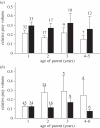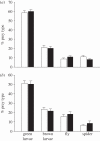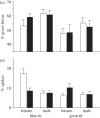Social learning in birds and its role in shaping a foraging niche
- PMID: 21357219
- PMCID: PMC3049099
- DOI: 10.1098/rstb.2010.0343
Social learning in birds and its role in shaping a foraging niche
Abstract
We briefly review the literature on social learning in birds, concluding that strong evidence exists mainly for predator recognition, song, mate choice and foraging. The mechanism of local enhancement may be more important than imitation for birds learning to forage, but the former mechanism may be sufficient for faithful transmission depending on the ecological circumstances. To date, most insights have been gained from birds in captivity. We present a study of social learning of foraging in two passerine birds in the wild, where we cross-fostered eggs between nests of blue tits, Cyanistes caeruleus and great tits, Parus major. Early learning causes a shift in the foraging sites used by the tits in the direction of the foster species. The shift in foraging niches was consistent across seasons, as showed by an analysis of prey items, and the effect lasted for life. The fact that young birds learn from their foster parents, and use this experience later when subsequently feeding their own offspring, suggests that foraging behaviour can be culturally transmitted over generations in the wild. It may therefore have both ecological and evolutionary consequences, some of which are discussed.
Figures




References
-
- Borenstein E., Feldman M. W., Aoki K. 2008. Evolution of learning in fluctuating environments: when selection favors both social and exploratory individual learning. Evolution 62, 586–60210.1111/j.1558-5646.2007.00313.x (doi:10.1111/j.1558-5646.2007.00313.x) - DOI - DOI - PubMed
-
- van der Post D. J., Hogeweg P. 2009. Cultural inheritance and diversification of diet in variable environments. Anim. Behav. 78, 155–16610.1016/j.anbehav.2009.04.009 (doi:10.1016/j.anbehav.2009.04.009) - DOI - DOI
-
- Whiten A., Hinde R. A., Laland K. N., Stringer C. B. 2011. Culture evolves. Phil. Trans. R. Soc. B 366, 938–94810.1098/rstb.2010.0372 (doi:10.1098/rstb.2010.0372) - DOI - DOI - PMC - PubMed
-
- Rieucau G., Giraldeau L.-A. 2011. Exploring the costs and benefits of social information use: an appraisal of current experimental evidence. Phil. Trans. R. Soc. B 366, 949–95710.1098/rstb.2010.0325 (doi:10.1098/rstb.2010.0325) - DOI - DOI - PMC - PubMed
-
- Thornton A., Clutton-Brock T. 2011. Social learning and the development of individual and group behaviour in mammal societies. Phil. Trans. R. Soc. B 366, 978–98710.1098/rstb.2010.0312 (doi:10.1098/rstb.2010.0312) - DOI - DOI - PMC - PubMed
MeSH terms
LinkOut - more resources
Full Text Sources
